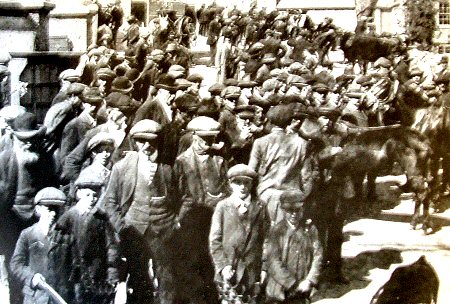John Mitchel is even today frequently lambasted for claims he made that British policy towards Ireland after the Union was deliberately designed to remove the great mass of poor from their holdings, the land, the country and the face of the earth. Yet Reports from Commissions of Inquiry set up by successive British governments – and action (and inaction) taken as a result – give strong if circumstantial evidence in support of Mitchel’s words.
The Devon Commission of 1833 estimated that of the country’s population of over 8 million, some 2,385,000 were ‘in great need of food’. Its strong recommendations for urgent investment in wealth- and employment-creating schemes went unheeded and the Government went ahead with the Workhouses designed to deter the ‘work-shy’. The subsequent potato failure and Great Hunger, disease, campaign of farm-amalgamation, dispossession, eviction and enforced emigration saw a massive shift in the population profile by the end of the century. The Vice-Regal Commission on Poor Law Reform 1906 blamed famine, disease, eviction and emigration which affected the poorer classes more than most.
The latter Commission in 1906 estimated some 30,000 of a population of four and a half million to be dependent upon Poor Relief. (The numbers again dropped dramatically from 1908 onwards with the introduction of Old Age Pensions). This was less than one per cent compared with thirty per cent of a population twice the size, some seventy years previously.
Where had they all gone? We will soon upload a personal story of an ‘American Wake’. A sizable fraction of those who had not fled the country had died of disease or hunger. The suffering of the poor was hugely disproportionate as a result of deliberate Government policy.
Of the 30,000 mentioned, some 2,000 were classified as vagrant or tramps. The Commission estimated that eighty per cent of these were male. They were of two types, one being old and infirm but basically decent and generally well-known and respected within their own locality. The other type has for centuries been the greatest object of hatred for governments: the ‘young and able, lazy ne’er-do-wells, dishonest and potentially dangerous’. The Commission recommended the setting up of Labour Houses wherein they might be confined to learn ‘habits of sobriety, regularity and industry’.
The Newry Reporter and other local papers reported the activities of tramps in this area – ‘infested with a tramp plague’ was a commonly heard expression – and special courts were frequently convened to deal with the problem. For begging, two months in prison with hard labour was a regular sentence.
Yet then (and before and since!) there was a great deal of local sympathy especially for those tramps who were recognized simply as colourful characters.
We have featured a number. Later a few more.
